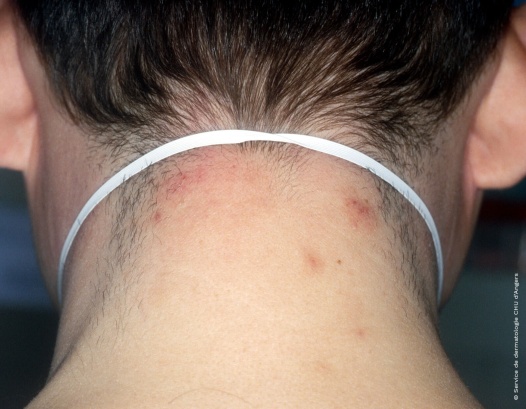

Eczema on the face and neck

Around the mouth or the eyes, on the eyelids, the nose and even the ears...
Eczema, whether atopic or allergic, often appears on the face and neck.
Allergic eczema on the face or neck
Contact eczema is caused by an allergy. It occurs when your skin has an allergic reaction after coming into contact with a specific product. You may have been exposed to this product several times in the past without having a reaction. Indeed, one characteristic of contact eczema is that the allergy can appear suddenly.
Some well-known allergy triggers
cosmetics, shampoo, hair dye, toothpaste, costume jewelry (necklace, earrings), topical medicines, personal care products, musical instruments (that touch the lips), eye drops (eyelids), etc.
-
through the hands touching the face or neck: nail polish, creams, personal care products, etc.
-
through the air: fragrances, solvents, paint, wood dust, certain plants
- through another person touching your face or neck: day creams, sunscreen, hair dye, etc.
The most clear-cut example is an allergy to costume jewelry earrings. This allergen is often the easiest to identify.
Through the hands
Many contact allergies on the face and neck actually originate from the hands, due to how often we touch our face and neck. A classic example is nail polish which, despite not having triggered a reaction on the fingers, triggers one on the eyelids (where the skin is so thin!), or even the neck, as a result of touching these areas with your hands. The same can occur with a cream or other cosmetic product applied to the hands. Contact eczema can be caused by indirect contact with an allergen via the hands, in other words “by hand transfer”.
Through the air
Allergens can come into contact with your skin by traveling through the air, such as fragrances for example. This is referred to as “airborne contact”.
Through another person
Indirect contact can also occur through another person, such as a father who, for example, applies cream to his hands prior to holding his baby. This is known as “by proxy contact”.

You are never allergic to an object or product in itself, but rather to an allergen in that object or product... which can therefore be a component of other products or objects.
How do you determine the cause of the allergy?
You will first need to identify the trigger for the contact allergy in order to eliminate it from your daily routine. Although the cause may be obvious, it is still best to consult a doctor, as you may need to look back and explore your past activities to find the cause (allergic reactions can appear long after the initial contact, sometimes even weeks later).
Your doctor will be able to identify more elusive triggers by asking detailed questions and conducting allergy tests. The allergologist will also be able to advise on what you should avoid, as an allergen can be found in several different products or objects.

What about a photoallergy?
Some contact allergies are triggered by the presence of a product in combination with sun exposure! More specifically, exposure to certain UV rays can cause an allergic reaction to a product in contact with the skin. Naturally, the face is exposed to the sun’s rays and is thus more susceptible.
In the case of photoallergic eczema, the most common causes are medicines and sunscreen.
Atopic eczema on the face or neck
Atopic eczema affects these areas of the body most often in infants and adults.
In infants, it is usually the first area affected by eczema. It appears on the “convexities”, especially the cheeks (more patches may also appear on other areas of the body).
In adults, eczema patches tend to appear on several areas: the hands, the crook of the arms, etc.
This type of eczema is caused by atopy rather than by an allergy. Atopy is a genetic hypersensitivity to the environment and can also manifest as asthma or rhinitis. In people with atopic skin, eczema appears in flare-ups alternating with periods of remission.
For more information, check out this in-depth overview of atopic eczema.
Face eczema: What to apply and what to avoid?
In the case of an allergy, you should of course avoid applying cosmetics, creams or make-up that contain the identified allergen to your face and neck.
In the case of atopic eczema, you should avoid contact with any substance that may worsen flare-ups (irritants such as soap) or trigger a contact allergy on top of everything else (products containing essential oils or fragrances or with a long list of ingredients).
How to get soothing relief from eczema on the face or neck?
To soothe itching in any case, the doctor will prescribe a topical corticosteroid (cortisone cream), which is the go-to treatment for eczema flare-ups.
In addition:
- for atopic eczema: the skin, which is often very dry, will need to be repaired using an emollient (hydrating) in order to make it less reactive.
- for allergic eczema: the allergen will need to be identified and removed from your routine.
Is eczema on the face/neck caused by stress?
No. Eczema always has a physiological cause: an allergy, atopic skin or some other source. You therefore cannot say that eczema is “all in your head”. However, stress can be an aggravating factor or even a trigger for flare-ups (in cases of atopic eczema), so it does play a role. But stress is never the cause.
Eczema, Seborrheic Dermatitis, or Psoriasis?
Eczema, seborrheic dermatitis, and psoriasis have similar symptoms. To differentiate them, one must observe the location of the patches, their color, their edges, and whether there is itching or not.
Eczema or seborrheic dermatitis?
In adults, the red, scaly seborrheic dermatitis patches take hold in the folds on both sides of the nose and along the edge of the scalp, which is also afflicted with “itchy dandruff”. A fungus is partly to blame for this disease.
Eczema or psoriasis?
Eczema patches are generally thinner and their edges less defined compared to psoriasis. Click here for a summary of the major differences between eczema and psoriasis.
Consult an expert physician to get an accurate diagnosis and to receive the appropriate treatment and advice. The treatment is not necessarily the same, antifungals for seborrheic dermatitis, general treatment for psoriasis if it is widespread elsewhere.
What are the possible complications of facial eczema?
If facial eczema is not treated appropriately, the patient may face potential complications. The most common is infection:
- Bacterial superinfection, known as impetiginization, is due to bacteria (streptococci or staphylococci) infiltrating the lesions from scratching; it may be necessary to administer antiseptic or antibacterial treatment.
- Superinfection of eczema by the herpes virus is rare. The eczema then becomes covered with large painful vesicles and is accompanied by fever.
Exceptionally, in the case of abnormally prolonged treatment with cortisone creams, rosacea may appear, which requires appropriate treatment.










